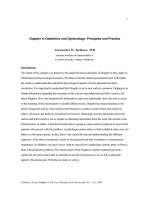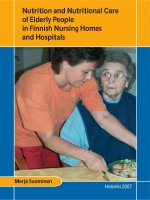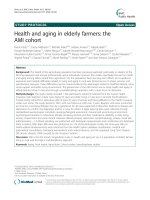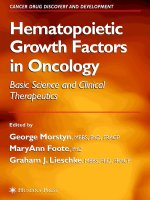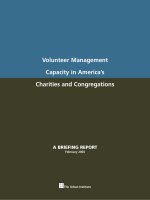Breathing in America: Diseases, Progress, and Hope pptx
Bạn đang xem bản rút gọn của tài liệu. Xem và tải ngay bản đầy đủ của tài liệu tại đây (11.67 MB, 282 trang )
Breathing in America:
Diseases, Progress,
and Hope
Edited by Dean E. Schraufnagel, MD
Published by the American Thoracic Society, which gratefully acknowledges support and technical
review from the National Heart, Lung, and Blood Institute, National Institutes of Health.
© 2010 by the American Thoracic Society
All rights reserved. Published 2010
Cover design: Dorcas Gelabert
Whitebook_breathing_FM.indd ii 5/10/10 5:54:00 PM
Breathing in America:
Diseases, Progress,
and Hope
Edited by Dean E. Schraufnagel, MD
Managing Editor
Brian Kell, MA
Art Director
Dorcas Gelabert, MFA
Illustration
Wendolyn B. Hill, MFA, CMI
Assistant Editor
Keely Savoie, MA
Editorial Assistant
Blythe Pack, BA
Whitebook_breathing_FM.indd i 5/10/10 12:54:44 PM
This page left intentionally blank
iii
Editorial Contributors . . . . . . . . . . . . . . . . . . . . . . . . . . . . . . . . . . . .v
Foreword . . . . . . . . . . . . . . . . . . . . . . . . . . . . . . . . . . . . . . . . . . . . . . ix
Senator Mike Crapo
Preface . . . . . . . . . . . . . . . . . . . . . . . . . . . . . . . . . . . . . . . . . . . . . . . .x
Dean E. Schraufnagel
Major Structures of the Lung . . . . . . . . . . . . . . . . . . . . . . . . . . . . .xii
Illustration
1 To breathe . . .
Alfred Munzer, David M. Mannino, Zhi-Jie Zheng,
and Dean E. Schraufnagel . . . . . . . . . . . . . . . . . . . . . . . . . . . . . . .1
2 Acute Respiratory Distress Syndrome
Leonard D. Hudson . . . . . . . . . . . . . . . . . . . . . . . . . . . . . . . . . . .15
3 Asthma
William W. Busse . . . . . . . . . . . . . . . . . . . . . . . . . . . . . . . . . . . . .25
4 Bronchiectasis
Timothy R. Aksamit and Dean E. Schraufnagel . . . . . . . . . . . . . .37
5 Chronic Obstructive Pulmonary Disease (COPD)
David M. Mannino, Janet B. Croft, and David W. Brown . . . . . . . .47
6 Collagen Vascular Lung Disease
Reda E. Girgis . . . . . . . . . . . . . . . . . . . . . . . . . . . . . . . . . . . . . . .57
7 Cystic Fibrosis
Manu Jain and Susanna A. McColley . . . . . . . . . . . . . . . . . . . . . .67
8 Environmentally Induced Lung Disease
Lisa A. Maier and David A. Schwartz . . . . . . . . . . . . . . . . . . . . . .77
9 Fungal Lung Disease
Chadi A. Hage . . . . . . . . . . . . . . . . . . . . . . . . . . . . . . . . . . . . . . .89
10 Interstitial Lung Disease
Amy L. Olson, Marvin I. Schwarz, and Jesse Roman . . . . . . . . . .99
Table of Contents
Whitebook_breathing_FM.indd iii 5/10/10 10:29:28 PM
iv
11 Lung Cancer
Lynn T. Tanoue . . . . . . . . . . . . . . . . . . . . . . . . . . . . . . . . . . . . . .109
12 Nontuberculous (Environmental) Mycobacterial Disease
Charles L. Daley. . . . . . . . . . . . . . . . . . . . . . . . . . . . . . . . . . . . .121
13 Occupational Lung Diseases
Eric Bonura and William N. Rom. . . . . . . . . . . . . . . . . . . . . . . . .131
14 Pleural Disease
Alice M. Boylan and V. Courtney Broaddus. . . . . . . . . . . . . . . . .145
15 Pneumonia
Marc Peters-Golden . . . . . . . . . . . . . . . . . . . . . . . . . . . . . . . . . .155
16 Pulmonary Embolism
Karen A. Fagan. . . . . . . . . . . . . . . . . . . . . . . . . . . . . . . . . . . . . .165
17 Pulmonary Hypertension
John H. Newman and Anna R. Hemnes . . . . . . . . . . . . . . . . . . .175
18 Rare Lung Diseases
Francis X. McCormack . . . . . . . . . . . . . . . . . . . . . . . . . . . . . . . .185
19 Respiratory Distress Syndrome of the Newborn
J. Usha Raj and Jo Rae Wright. . . . . . . . . . . . . . . . . . . . . . . . . .197
20 Respiratory Failure
Nicholas S. Hill . . . . . . . . . . . . . . . . . . . . . . . . . . . . . . . . . . . . . .207
21 Sarcoidosis
Michael C. Iannuzzi . . . . . . . . . . . . . . . . . . . . . . . . . . . . . . . . . .217
22 Sepsis
Min J. Joo and John W. Christman . . . . . . . . . . . . . . . . . . . . . . .227
23 Sleep-Disordered Breathing
Bharati Prasad, Janet B. Croft, and Yong Liu . . . . . . . . . . . . . . .237
24 Tuberculosis
Dean E. Schraufnagel. . . . . . . . . . . . . . . . . . . . . . . . . . . . . . . . .249
25 The Challenge
Dean E. Schraufnagel and Gerard Turino. . . . . . . . . . . . . . . . . .259
Whitebook_breathing_FM.indd iv 5/10/10 12:54:44 PM
v
Timothy R. Aksamit, MD
Consultant, Mayo Clinic
Donna J. Appell, RN
President and Founder
Hermansky-Pudlak Syndrome Network Inc.
Eric Bonura, MD
Fellow, Division of Pulmonary and Critical
Care Medicine
New York University School of Medicine
Alice M. Boylan, MD
Associate Professor of Medicine
Director, Medical Acute and Critical Care
Medical University of South Carolina
Division of Pulmonary and Critical Care
V. Courtney Broaddus, MD
Professor of Medicine
Chief, Division of Pulmonary and
Critical Care Medicine
San Francisco General Hospital
Associate Director
Lung Biology Center
University of California at San Francisco
David W. Brown, MScPH, MSc
Centers for Disease Control and Prevention
William W. Busse, MD
George R. and Elaine Love Professor
Chair, Department of Medicine
University of Wisconsin School of Medicine
and Public Health
John W. Christman, MD
Professor of Medicine and Pharmacology
Section of Pulmonary, Critical Care,
Sleep, and Allergy
University of Illinois at Chicago
Stephen C. Crane, PhD, MPH
Executive Director
The American Thoracic Society
Janet B. Croft, PhD
Senior Epidemiologist
National Center for Chronic Disease
Prevention and Health Promotion
Centers for Disease Control and Prevention
J. Randall Curtis, MD, MPH
Professor of Medicine
University of Washington
Harborview Medical Center
Charles L. Daley, MD
Head, Division of Mycobacterial and
Respiratory Infections
National Jewish Health
Professor of Medicine
University of Colorado Denver
Fran DuMelle, MS
Senior Director, International Programs
and Activities
The American Thoracic Society
Gary Ewart, MHS
Senior Director of Government Relations
The American Thoracic Society
Editorial Contributors
Whitebook_breathing_FM.indd v 5/10/10 10:29:55 PM
vi
Karen A. Fagan, MD
Associate Professor of Medicine
Chief, Division of Pulmonary Sciences and
Critical Care Medicine
University of South Alabama
Reda E. Girgis, MB BCh
Associate Professor of Medicine
Co-Director, Pulmonary Hypertension Program
Associate Medical Director, Lung
Transplantation
Johns Hopkins University
Chadi A. Hage, MD
Assistant Professor of Medicine
Pulmonary-Critical Care Medicine and
Infectious Diseases
Indiana University School of Medicine
Roudebush VA Medical Center
Anna R. Hemnes, MD
Assistant Professor of Medicine
Assistant Director
Pulmonary Vascular Center
Division of Allergy, Pulmonary and Critical
Care Medicine
Vanderbilt University School of Medicine
Nicholas S. Hill, MD
Professor of Medicine
Tufts University School of Medicine
Chief, Division of Pulmonary, Critical Care
and Sleep Medicine
Tufts Medical Center
Leonard D. Hudson, MD
Professor of Medicine
Division of Pulmonary and Critical Care
Medicine
University of Washington
Michael C. Iannuzzi, MD, MBA
Professor and Chair
Department of Medicine
SUNY Upstate Medical University
David Ingbar, MD
Professor of Medicine, Physiology & Pediatrics
Director of Pulmonary, Allergy and
Critical Care Division
University of Minnesota
Manu Jain, MD, MS
Associate Professor of Medicine and Pediatrics
Director of Adult Cystic Fibrosis Program
Northwestern University Feinberg School of
Medicine
Min J. Joo, MD, MPH
Assistant Professor of Medicine
Section of Pulmonary, Critical Care Sleep,
and Allergy
University of Illinois at Chicago
Brian Kell, MA
Senior Director of Communications
and Marketing
The American Thoracic Society
James P. Kiley, PhD
Director of the Division of Lung Diseases
National Heart, Lung, and Blood Institute
Landon S. King, MD
David Marine Professorship in Medicine
Director, Pulmonary and Critical
Care Medicine
Johns Hopkins School of Medicine
Alan R. Leff, MD
Professor of Medicine
University of Chicago
Whitebook_breathing_FM.indd vi 5/10/10 8:45:50 PM
vii
Yong Liu, MPH
Biostatistician, Division of Adult and
Community Health
National Center for Chronic Disease
Prevention and Health Promotion
Centers for Disease Control and Prevention
Robert Loddenkemper, MD
Professor of Medicine,
Charité Universitätsmedizin Berlin
Former Medical Director of
HELIOS Klinikum Emil von Behring
and Chief of Department of Pneumology II at
Lungenklinik Heckeshorn (Berlin)
Lisa A. Maier, MD, MSPH
Head, Division of Occupational &
Environmental Health Sciences
National Jewish Health
Associate Professor of Medicine
University of Colorado Denver
David M. Mannino, MD
Associate Professor of Medicine
Division of Pulmonary, Critical Care,
and Sleep Medicine
Director of the Pulmonary Epidemiology
Research Laboratory
University of Kentucky
Susanna A. McColley, MD
Associate Professor of Pediatrics
Northwestern University Feinberg School
of Medicine
Head, Division of Pulmonary Medicine
Director, Cystic Fibrosis Center
Francis X. McCormack, MD
Taylor Professor and Division Director
Pulmonary, Critical Care & Sleep Medicine
University of Cincinnati
Alfred Munzer, MD
Director of Pulmonary Medicine
Washington Adventist Hospital
John H. Newman, MD
Elsa S. Hanigan Professor of
Pulmonary Medicine
Division of Allergy, Pulmonary and
Critical Care Medicine
Vanderbilt University School of Medicine
Amy L. Olson, MD, MSPH
Assistant Professor
Interstitial Lung Disease Program
National Jewish Health
Marc Peters-Golden, MD
Professor of Internal Medicine
Director, Fellowship Program in Pulmonary
and Critical Care Medicine
University of Michigan Health System
Bharati Prasad, MD
Assistant Professor
University of Illinois Medical Center
at Chicago
J. Usha Raj, MD
Professor and Head
Department of Pediatrics
University of Illinois at Chicago
William N. Rom, MD, MPH
Sol and Judith Bergstein Professor of Medicine
Director, Division of Pulmonary and
Critical Care Medicine
New York University School of Medicine
Jesse Roman, MD
Professor and Chairman of Medicine
University of Louisville Health Sciences Center
Whitebook_breathing_FM.indd vii 5/10/10 10:37:20 PM
viii
Keely Savoie, MA
Science Writer and Senior Media Liaison
The American Thoracic Society
Dean E. Schraufnagel, MD
Professor of Medicine and Pathology
Section of Pulmonary, Critical Care,
Sleep and Allergy
The University of Illinois at Chicago
David A. Schwartz, MD
Director, Center for Genetics and Therapeutics
Provost, National Jewish Health
Marvin I. Schwarz, MD
Professor of Medicine
Co-Head, Division of Pulmonary Sciences
and Critical Care Medicine
University of Colorado Health Sciences Center
Lynn T. Tanoue, MD
Professor of Medicine
Pulmonary and Critical Care Medicine
Yale University School of Medicine
Gerard Turino, MD
Founding Director
James P. Mara Center for Lung Disease
St. Luke’s-Roosevelt Hospital Center
John H. Keating Sr. Professor of Medicine
(Emeritus)
Columbia University College of Physicians
& Surgeons
Adam Wanner, MD
Joseph Weintraub Professor of Medicine
University of Miami Miller School of Medicine
Ewald R. Weibel, MD, DSc (hon)
Professor Emeritus of Anatomy
Institute of Anatomy
University of Berne
Gail G. Weinmann, MD
Deputy Director of the Division of
Lung Diseases
National Heart, Lung, and Blood Institute
Jo Rae Wright, PhD
Professor, Department of Cell Biology,
Pediatrics and Medicine
Vice Provost & Dean of the Graduate School
Duke University School of Medicine
Zhi-Jie Zheng, MD, MPH, PhD
Senior Medical Epidemiologist and
Program Director, Research Translation
Division for the Application of Research
Discoveries
National Heart, Lung, and Blood Institute
Whitebook_breathing_FM.indd viii 5/10/10 8:45:50 PM
ix
Respiratory issues affect millions of Americans, robbing them of their health,
happiness, and even of life itself. Asthma, COPD, lung cancer, and sleep apnea
are just a few of the important respiratory conditions that pose major threats to
our citizens. Just as importantly, airborne threats such as infl uenza, air pollution,
and bioterrorism can spread rapidly through the air, affecting enormous num-
bers of people in a very short period of time. Moreover, tobacco smoke kills
more Americans in one year than all the wars our nation fought during the last
century.
Congress has recognized the importance of respiratory health and has em-
barked on programs to make a difference. From 1998–2003, Congress doubled
the budget of the National Institutes of Health. We have strengthened the Centers
for Disease Control and Prevention, granted the Food and Drug Administration the
ability to regulate tobacco, improved pollution control through the Environmental
Protection Agency, and funded tuberculosis programs throughout the world
because we realize that in order to control tuberculosis at home, we need to control
it worldwide.
The money invested in research has been money well spent. Americans are
living longer and healthier and, for the most part, breathing easier. Some previ-
ously untreatable diseases, such as respiratory distress of the newborn—once
a leading cause of infant mortality—now have treatments; others have cures
within their grasp.
Research is essential for the United States to remain a world leader in the
development of health advances. The benefi ts of research extend beyond healthy
citizens. Research improves our nation’s productivity, increases employment, and
improves the fi nancial well-being of our citizens. More progress must be made,
both in understanding disease processes in order to develop cures and in bringing
these advances to everyone.
I congratulate the American Thoracic Society on this book, which highlights
many of the advances that recent research has brought about and demonstrates
the value of working together to improve the lung health of Americans.
Mike Crapo
United State Senator, Idaho
Foreword
Whitebook_breathing_FM.indd ix 5/10/10 12:54:45 PM
x
Breathing in America: Diseases, Progress, and Hope briefl y describes respira-
tory diseases and the progress that is being made in the quest to fi nd their
cures. It describes who is vulnerable to developing these diseases, what it is like
to have them, and their burden on society. It tells about prevention, treatment,
and ways to stay healthy. And, most importantly, it explains where we are in
understanding the disease processes, how close research is to developing new
tests and treatments, and what still needs to be done.
Many factors went into developing this book. Nearly a decade ago, the
European Respiratory Society sought to identify variations in lung diseases
across different European nations. In 2003, it published the European Lung
White Book, a report that helped to increase awareness of the high toll of lung
diseases. The Forum for International Respiratory Societies, which is composed
of organizations including the American Thoracic Society, the European Respi-
ratory Society, the Asociación Latinoamericana del Tórax, the American College
of Chest Physicians, the Asian Pacifi c Society of Respirology, the International
Union Against Tuberculosis and Lung Disease, and the Pan African Thoracic
Society, determined that a similar report should be completed for each region of
the world. The American Thoracic Society agreed to undertake this project for
the United States.
The American Thoracic Society frequently receives inquiries from the media,
patients, and the public at large regarding specifi c lung diseases and scientifi c
advances in respiratory research. To address these inquiries, staff members
thought that a short review of respiratory diseases would be helpful. There have
long been advocates within the American Thoracic Society for a publication that
covered the topics now found in Breathing in America: Diseases, Progress, and
Hope. The American Thoracic Society’s Research Advocacy Committee, for ex-
ample, believes that increased awareness of respiratory disease will expand
support for respiratory research, which—by just about any measure—is under-
funded when considering the number of lives affected. The committee produced
a document that outlined the research that is needed and the areas where that
research could make a major impact. The American Thoracic Society’s Public
Advisory Roundtable consists of patient advocacy groups for various respiratory
and critical illnesses. This group strongly supports research, which they see as
the best hope for improving the lives of people with respiratory diseases. Patient
Preface
Whitebook_breathing_FM.indd x 5/10/10 12:54:45 PM
xi
advocates remind us that the burden of lung diseases extends far beyond the
numbers of persons who suffer or die from a respiratory illness.
These factors came together to become the impetus behind this book. Then
American Thoracic Society President Jo Rae Wright, PhD, and the American
Thoracic Society staff applied for a grant from the National Heart, Lung, and
Blood Institute to allow production to begin.
The book is part of the American Thoracic Society’s 2010 Year of the Lung
campaign, an inclusion that required a short timeline to publication. The con-
tributors, reviewers, and advisors carried out the needed tasks with amazing
commitment, thoroughness, and promptness. None of it would have been pos-
sible without the great efforts of Brian Kell, the managing editor, who worked
tirelessly to make this book happen.
Dean E. Schraufnagel, MD
Editor
Whitebook_breathing_FM.indd xi 5/10/10 12:54:45 PM
xii
Bronchioles
LUNG
Alveoli
Bronchi
Trachea
Pleura
Major Structures of the Lung
Whitebook_breathing_FM.indd xii 5/10/10 12:54:45 PM
1
To breathe . . .
To breathe is to live.
And yet people everywhere live with, and die from, breathing disorders.
Those who suffer may be young or old. They may have a breathing problem
from birth or develop it after years of working in certain environments. They may
fi nd that medical treatment can greatly relieve their symptoms or that little can
be done to help them. They may live relatively normal lives or suffer major dis-
ability and an early death. They may wonder if a cure is around the corner or will
not come in their lifetime.
The respiratory system suffers many onslaughts. Cigarette smoke, air pol-
lution, and airborne infections are three major ones, but lack of awareness of the
harm they do is an even greater danger. Together, respiratory diseases kill more
than 400,000 Americans each year, making them the third leading cause of
death in the United States (1). For millions more, respiratory diseases signifi -
cantly reduce quality of life. Being unable to breathe can be a terrifying experi-
ence, yet it is one that many face everyday.
Despite the commonplace and seriousness of respiratory conditions, they
are often under-appreciated in discussions and decisions about public health.
Perhaps this is because these conditions can take many forms. Some disorders,
such as asthma, are common, affecting 19 million children and 16 million
Whitebook_breathing_Ch01.indd 1 5/10/10 8:27:40 AM
To breathe . . . CHAPTER 1
2
adults (2). Others, such as the Hemansky-Pudlak syndrome, are rare. Some,
such as sarcoidosis, more commonly affect African Americans, while others,
such as cystic fi brosis, more often affect Caucasians. Cystic fi brosis, one of the
most common genetic disorders among Caucasians, manifests itself in early
childhood. Lung fi brosis and lung cancer affect older adults. Still others, such as
tuberculosis and sleep apnea, can strike at any age.
Many forms of lung disease disproportionately affect the socioeconomically
disadvantaged, but all classes of people must breathe and no one, whether
defi ned by age, gender, race, ethnicity, or socioeconomic level, is immune from
respiratory problems and their potentially devastating impact.
Because populations share the same air, environmental exposures can
affect large numbers of people, frequently at the same time. Infectious lung dis-
ease can be transmitted by humans, and environmental lung disease can be
transmitted by human activity. Lung disease may result from as yet unknown
factors in the air. And most lung diseases can occur without warning.
Lung cancer is the most common cause of cancer death in the United States
and in the rest of the world. In the United States, more than 160,000 people died
from lung cancer in 2009. That is more than from cancers of the breast, colon,
10,000
1,000
100
10
2005
200019901980
All causes
Heart disease
Cancer
Stroke
Unintentional injuries
Chronic lower
respiratory diseases
197019601950
Deaths per 100,000 population (log scale)
Year
Of the six leading causes of death, only COPD (categorized as a chronic lower respiratory disease on
the right)
has become a more common cause over the past 30 years. National Center for Health
Statistics. Health, United States, 2008 With Chartbook. Hyattsville, MD: 2009.
Death rates for leading causes of death for all ages: United States, 1950–2005
Whitebook_breathing_Ch01.indd 2 5/10/10 8:27:42 AM
CHAPTER 1 To breathe . . .
3
While the death rates from most cancers have stayed the same or decreased over the past 75 years,
that for lung cancer have increased dramatically. Fortunately, among men, the death rate appears to
have peaked in 1990. Among women, it also appears to have peaked, though more recently. American
Cancer Society. Cancer Facts and Figures 2009. Atlanta: American Cancer Society; 2009.
Age-adjusted cancer death rates, males by site, US, 1930–2005
Age-adjusted cancer death rates, females by site, US, 1930–2005
0
1930 1935 1940 1945 1950 1955 1960 1965 1970 1975 1980 1985 1990 1995 2000 2005
20
40
60
80
100
Lung & bronchus
Colon & rectum
Pancreas
Liver
Leukemia
Prostate
Stomach
Rate per 100,000 male population
Lung & bronchus
Colon & rectum
Breast
Pancreas
Stomach
Ovary
Uterus
0
1930 1935 1940 1945 1950 1955 1960 1965 1970 1975 1980 1985 1990 1995 2000 2005
20
40
60
80
100
Rate per 100,000 female population
Whitebook_breathing_Ch01.indd 3 5/10/10 8:27:42 AM
To breathe . . . CHAPTER 1
4
pancreas, and prostate combined (3). More women die from lung cancer than
from breast cancer.
Chronic obstructive pulmonary disease (COPD) affects 6.8 percent of adults
(4) and is responsible for about 700,000 hospitalizations and 127,000 deaths
annually in the United States (1,5). But more than half of people with COPD
have not been diagnosed (6). Only heart disease, cancer, and stroke kill more
people, but while deaths from those diseases are declining, the number of
people dying from COPD is growing. By 2020, if recent mortality trends con-
tinue, COPD is expected to kill more Americans than stroke (7,8). Infl uenza and
its sequelae pneumonia claim over 40,000 lives annually. Asthma, though usu-
ally not fatal, is also a growing problem. Among children, asthma cases more
than doubled between 1980 and the mid-1990s; 6 percent of all American chil-
dren now have asthma (9).
During the past two decades, sleep-disordered breathing has become
recognized as a major health problem that may affect up to 10 percent of
Americans. From 1990 to 2005, physician offi ce visits for sleep apnea increased
from 108,000 to 3.4 million in the United States, and most people with sleep
apnea go undiagnosed and untreated (1).
Economic burden of lung disease
The economic cost of lung disease, both to individuals and to society, is vast.
The U.S. Environmental Protection Agency estimated that in 1999, the average
annual cost of treating a patient for asthma ranged from $761 to $889, depend-
ing on age (10). Asthma has other costs including missed time from school and
work; school absences total about 12.8 million days per year. Costs are also
borne by family members who need to miss work to obtain care for asthma,
especially for children. The annual cost of asthma exceeds $19 billion per year
in the United States (11,12). Researchers at a health economics fi rm estimated
that the annual cost of providing COPD-related medical services was even
higher, ranging in 2005 from $2,700 to $5,900 per person (13).
The National Heart, Lung, and Blood Institute estimated that in 2009, the
annual cost of providing healthcare related to all respiratory conditions, exclud-
ing lung cancer, was $113 billion. The institute further estimated that the cost to
American society, in terms of lost productivity as a result of disability and early
death due to respiratory disease, amounted to an additional $67 billion (1).
Whitebook_breathing_Ch01.indd 4 5/10/10 8:27:42 AM
CHAPTER 1 To breathe . . .
5
A wonderful organ
The lung is a wonderful organ built of a complex tree of airways that are, in an
average person, 44 miles long and serve to ventilate 300 to 500 million alveoli,
or air sacs, with a total surface area nearly the size of a tennis court. This sur-
face is covered by a dense meshwork of blood capillaries of total length of about
3,000 miles. About 85 percent of the alveolar surface is in contact with blood
across a tissue barrier 50 times thinner than a sheet of onion skin paper, which
allows a very effi cient uptake of oxygen (14).
Breathing is regulated through a complex interaction between oxygen and
carbon dioxide sensors located in the arteries and the brainstem, which respond
to subtle changes in acidity. Sensors located in the lung and chest wall muscles
respond to expansion and contraction, sending signals to the central respiratory
controllers in the brainstem. The controllers help direct the respiratory muscles,
triggering inspiration and expiration and regulating the depth of breathing. By
expelling carbon dioxide, the lungs eliminate more acid waste in one hour than
the kidneys do in an entire day.
The lung interacts with the environment
The lungs fi lter about 500 liters of air per hour or 12,000 liters per day. Inhaled
air contains infectious and noxious particles and gases, against which the lungs
must defend themselves. Mechanical factors, such as the structure of the nasal
passageway and bronchi, and functional factors, such as cough, prevent inva-
sion into the lung or expel invading elements. The thin layer of mucus, which
traps particles and dissolves gases, is constantly propelled by hair-like struc-
tures, called cilia, up the bronchi to the trachea and mouth, where they are swal-
lowed or expelled.
A variety of cells and lymphatic drainage also work to keep the lungs
clear and relatively dry. The macrophage is a cell that originates in the bone
marrow and migrates to the lung. It is capable of ingesting organisms and inert
particles and of killing bacteria. After taking up the foreign material, macrophages
may migrate up the bronchi and trachea to be swallowed or to the lymph nodes
where they initiate an infl ammatory or immune response. This response may
defend against infectious agents, but it can also provoke or be part of respiratory
diseases themselves.
Whitebook_breathing_Ch01.indd 5 5/10/10 8:27:42 AM
To breathe . . . CHAPTER 1
6
1965 1974 1979 1985
Year
1990 1995 2000 2007
20
10
30
40
50
60
Men
High school students
Pregnant women
Women
Percent
Most smokers start in their teenage years. The rise in adolescent smoking rates in the late 1990s may have
been due to tobacco industry advertising that targeted youth. The subsequent decline is associated with
increased prevention efforts by many states to curb advertising and offer counter-marketing messages.
National Center for Health Statistics. Health, United States, 2008 With Chartbook. Hyattsville, MD: 2009.
Percentage of Americans who smoke
An aerial view of a smokestack shows how quickly and extensively airborne material
spreads and why diseases such as infl uenza and tuberculosis can be so devastating.
Airborne particles can be toxic in quantities as small as a few parts per billion.
Dean E. Schraufnagel
Whitebook_breathing_Ch01.indd 6 5/10/10 8:27:42 AM
CHAPTER 1 To breathe . . .
7
How lung disease happens
The complexity of the respiratory system does not lend itself to easy classifi ca-
tion of its diseases, but one basic way to group them is by how they affect
pulmonary function, or breathing, tests. Diseases that affect the fl ow of air are
termed obstructive lung diseases and include asthma, emphysema, bronchitis,
bronchiolitis, and bronchiectasis. The airfl ow obstruction is primarily in the pas-
sageways to the alveoli, where oxygen and carbon dioxide exchange takes
place. Asthma is an infl ammatory or allergic condition but is distinguished by its
reversibility whereas the other conditions are not fully reversible. Bronchitis is an
infl ammation of the bronchi, and bronchiolitis is an infl ammation of the bronchi-
oles, the next segment of the airway that conducts air down to the alveoli. Em-
physema is characterized by a loss of lung elastic recoil that occurs when the
lungs are stretched at full inhalation. The loss of elasticity allows the lungs to
overinfl ate; the excessive stretching breaks alveolar walls, which leads to de-
creased area for oxygen and carbon dioxide exchange.
Diseases that decrease the volume of the lung are called restrictive lung
diseases. These diseases, such as pulmonary fi brosis, make breathing diffi cult
because of increased lung stiffness and the work it takes to breathe.
Lung diseases may also be classifi ed according to the disease-causing
process, such as genetic, developmental, neoplastic (cancer), vascular,
infl ammatory, infectious, and toxic. Among the clearly defi ned genetic disorders
of the lung are cystic fi brosis and alpha-1 antitrypsin defi ciency (a form of
emphysema). The most common developmental abnormality is the infant
respiratory distress syndrome (or respiratory distress of the newborn). Later-life
developmental abnormalities of the spine, such as scoliosis or kyphosis, can
also adversely affect breathing.
Although there are benign lung tumors, lung cancer is the most notorious of
all cancers. Lung disease may also involve the blood vessels in disorders such
as pulmonary embolism, which is associated with reduced blood fl ow and
impairment in oxygen uptake. More rare infl ammation of the blood vessels (vas-
culitis) also occurs. Diseases marked by infl ammation of the airway include
COPD, asthma, and bronchitis. Many diseases involve infl ammation of the
alveoli and the tissue next to them (interstitium). Sarcoidosis and fi brosis are
chronic infl ammatory diseases; if the infl ammation does not resolve and allow
the restoration of the normal structure, then scarring, or fi brosis, results. Pulmo-
nary fi brosis can be a deadly form of such scarring.
Whitebook_breathing_Ch01.indd 7 5/10/10 8:27:44 AM
To breathe . . . CHAPTER 1
8
Respiratory infections can be caused by viruses, bacteria, fungi, protozoa,
and larger parasites. Respiratory infections range from mild, such as the com-
mon cold or acute bronchitis, to devastating, such as the pneumonia caused by
Pneumocystis, which occurs in persons with the human immunodefi ciency virus
(HIV). Infectious agents may gain entry through the airway or the bloodstream.
Overwhelming bloodstream infection is termed sepsis.
Because the lungs are in constant contact with the environment, they are
especially susceptible to environmental toxins. Air pollution and toxic gases
cause a variety of respiratory problems. Assaults on the lung can come from
inhaling fumes or other noxious particles in the environment, such as tobacco
smoke, or from material that gains access to the lung from the bloodstream
(emboli). Exposure to high-oxygen concentrations can induce permanent lung
injury, even when given as a life-saving medical treatment.
If lung disease advances rapidly, it can lead to acute respiratory failure. If
lung disease progresses slowly, it can lead to chronic respiratory failure. Respi-
ratory failure is defi ned by the lungs’ inability to maintain a suffi cient level of
oxygen in the body or to clear carbon dioxide adequately. Respiratory failure can
also result from weakness of respiratory muscles and from abnormalities of the
chest wall and in the neural control of respiration. Impaired control of breathing
in the central nervous system can cause sleep apnea, and delayed development
of control of breathing in the brainstem has been invoked as a cause of sudden
infant death syndrome.
The changing face of lung disease
At the beginning of the 20
th
century, infectious diseases were identifi ed as the
cause of enormous public health problems (15). Each year, tuberculosis claimed
more than 2 of every 1,000 American lives in the United States (16). Scientists
knew what tuberculosis looked like under the microscope, but there was no
treatment. Today, scientists have deciphered the entire genome of Mycobacte-
rium tuberculosis and are able to cure tuberculosis—but not in everyone.
Although infectious diseases were thought to be conquered through scien-
tifi c advances, new microbial forms and altered human hosts (as seen with
acquired immune defi ciency syndrome [AIDS]) have led to their resurgence. In
the early 20
th
century, infl uenza claimed 20 million lives around the globe. Today,
the ill effects of infl uenza have been reduced by vaccines and medications—but
Whitebook_breathing_Ch01.indd 8 5/10/10 8:27:45 AM
CHAPTER 1 To breathe . . .
9
Major common lung diseases
Diseases of air movement and airways
Asthma
Bronchiectasis
Emphysema and chronic bronchitis (Chronic obstructive pulmonary disease, or COPD)
Bronchiolitis
Infectious lung diseases
Pneumonia (and lung abscess)
Pleural infections (empyema)
Fungal lung disease
Tuberculosis and other mycobacterial disease
Opportunistic lung infections in immunosuppressed persons
Pulmonary vascular diseases
Pulmonary embolism
Pulmonary hypertension
Congenital vascular anomalies
Congenital, genetic, and developmental lung diseases
Cystic fi brosis
Respiratory distress of the newborn
Alpha-1 antitrypsin defi ciency
Congenital lung disease
Bronchopulmonary dysplasia
Congenital syndromes affecting the lungs
Lung cancers
Benign lung tumors
Lung carcinoma
Cancer metastatic to the lung
(Continued )
Whitebook_breathing_Ch01.indd 9 5/10/10 8:27:45 AM
To breathe . . . CHAPTER 1
10
Environmental, exposure-related, and occupational lung diseases
Mineral dust pneumoconiosis (asbestosis, silicosis, coal workers’ pneumoconiosis)
Hypersensitivity pneumonia (organic material exposure)
Drug-induced lung disease
Occupational asthma
Toxic exposure
Interstitial lung diseases
Cryptogenic organizing pneumonitis
Hypersensitivity pneumonitis
Idiopathic pulmonary fi brosis
Interstitial lung disease associated with autoimmune disease
Nonspecifi c interstitial pneumonitis
Pulmonary Langerhans histiocytosis
Respiratory bronchiolitis-interstitial lung disease
Sarcoidosis
Lymphangioleiomyomatosis
Sleep-related and neuromuscular breathing disorders
Obstructive sleep apnea
Central sleep apnea
Amyotrophic lateral sclerosis
Myasthenia gravis
Traumatic spinal cord disease
Diseases of the pleura and chest wall
Pleural effusion
Mesothelioma
Kyphoscoliosis
Traumatic chest injury
Whitebook_breathing_Ch01.indd 10 5/10/10 8:27:45 AM
CHAPTER 1 To breathe . . .
11
the threat of new strains with great potential to spread and cause harm still
looms.
At the beginning of the 20
th
century, infant mortality was 13 times greater
than today (17,18), and respiratory distress of the newborn was unrecognized.
Today, surfactant replacement therapy has nearly eliminated this condition—but
infants still die of respiratory failure.
At the beginning of the 20
th
century, there was no effective treatment
for pneumonia. Today, there are scores of antibiotics that target bacterial
infections—but pneumonia still kills, even within hospitals.
At the beginning of the 20
th
century, the world had not reconciled the bene-
fi ts of the industrial revolution with the risks it imposed on its workers or, through
its smokestacks that polluted the air, to all people. Today, there are effective
worker protection laws and a national commitment to clean air. The reduction in
atmospheric ozone, oxides of nitrogen, and particulate pollution has resulted in
better quality of life and healthier lungs—but pollution still shortens lives.
Largely as a result of these and other medical advances and the public
health movement, life expectancy has increased over the past century from
47 to 76 years—but there are hazards afoot.
Lung health cannot be taken for granted. At the beginning of the 20
th
cen-
tury, tobacco smoking and lung cancer were rare. Today, multinational tobacco
enterprises promote a habit that kills 440,000 Americans every year, as
many lives lost as in all the wars fought by our country in the last hundred
years (19).
Respiratory failure
Acute and chronic respiratory failure
Acute respiratory distress syndrome
Sepsis
Shock
Multi-organ failure
Systemic disease affecting the respiratory system
Many diseases primarily affecting other organs
Autoimmune diseases
Whitebook_breathing_Ch01.indd 11 5/10/10 8:27:45 AM

